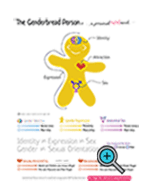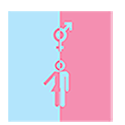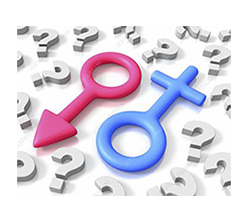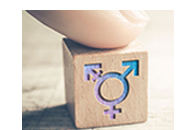


Diversity・Equality・Inclusion

Transgender people are people whose gender identity is different from the gender they were assigned at birth. “Trans” is often used as shorthand for transgender.
When we're born, a doctor usually says that we're male or female based on what our bodies look like. Most people who were labeled male at birth turn out to actually identify as men, and most people who were labeled female at birth grow up to be women. But some people's gender identity – their innate knowledge of who they are – is different from what was initially expected when they were born. Most of these people describe themselves as transgender.

Trans Man / Female To Male
A trans man is a man who was assigned female at birth. This is commonly referred to as female-to-male (FTM or F2M). The label of transgender man is not always interchangeable with that of transsexual man, although the two labels are often used in this way. Transgender is an umbrella term that includes different types of gender variant people (including transsexual people). Many trans men choose to undergo surgical or hormonal transition, or both (see sex reassignment therapy), to alter their appearance in a way that aligns with their gender identity or alleviates gender dysphoria.
Trans Woman / Male To Female
A trans woman is a woman who was assigned male at birth. This is commonly referred to as male-to-female (MTF or M2F). Trans women may experience gender dysphoria and may transition; this process commonly includes hormone replacement therapy and sometimes sex reassignment surgery, which can bring relief and resolve feelings of gender dysphoria. Trans women may be heterosexual, bisexual, homosexual, asexual, or identify with other terms (such as queer).Gender identity is the personal sense of one's own gender. Gender identity can correlate with a person's assigned sex at birth or can differ from it. Gender expression typically reflects a person's gender identity, but this is not always the case. While a person may express behaviours, attitudes, and appearances consistent with a particular gender role, such expression may not necessarily reflect their gender identity. The term gender identity was originally coined by Robert J. Stoller in 1964.
All societies have a set of gender categories that can serve as the basis of a person's self-identity in relation to other members of society. In most societies, there is a basic division between gender attributes assigned to males and females, a gender binary to which most people adhere and which includes expectations of masculinity and femininity in all aspects of sex and gender: biological sex, gender identity, and gender expression. Some people do not identify with some, or all, of the aspects of gender assigned to their biological sex; some of those people are transgender, non-binary, or genderqueer. Some societies have third gender categories.
Gender identity is usually formed by age three. After age three, it is extremely difficult to change gender identity. Both biological and social factors have been suggested to influence its formation.

What is gender incongruence or gender dysphoria?
Gender incongruence or gender dysphoria is a condition in which a person feels very uncomfortable with his or her innate physical gender. When a person is psychologically unable to identify with his or her physiological gender, as well as the gender role played and implied by his or her physiological gender in society, and strongly believes that he or she should belong to another gender, the person may have symptoms of gender identity disorder.What are the causes of gender incongruence or gender dysphoria?
Until now, the medical community has not been able to determine the causes of gender incongruence or gender dysphoria. Scholars believe that there are many causes of the disease, related to innate genes, background of growth, family environment and social factors.
How do I know I'm suffering from gender incongruence or gender dysphoria?
Patients may be from childhood has continued to believe that their gender is mismatched, but also for their gender mismatch problems plagued, resulting in psychological uneasines.According to the Diagnostic and Statistical Manual of mental illness published by the American Psychiatric Association, "gender incongruence or gender dysphoria" must meet five conditions:

